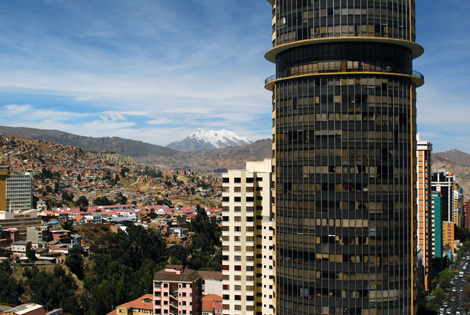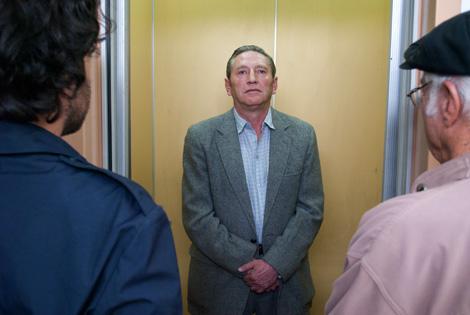It’s been said all literature is comprised of two stories: man goes on a journey; stranger comes to town. In her two-channel video, Sympathy for the Devil (2011), Claudia Joskowicz examines these alternate sides of the same coin, exploring the exile of two individuals, each inextricably linked to and affected by the other. The narrative for Sympathy is both personal and prosaic, while at the same time, historically significant.
Likewise, in a trilogy of videos dating 2007–09, Joskowicz staged scenes significant to the national consciousness of her native Bolivia—that have also taken on iconic status beyond Bolivia’s national boundaries. Drawn and Quartered (2007) depicts the execution of Bolivian revolutionary Túpac Katari at the hands of the Spanish in 1781; Vallegrande, 1967 (2008) reconstructs the Bolivian army’s display of the recently murdered Ché Guevara; and Round and Round and Consumed by Fire (2009) reenacts the last stand of Butch Cassidy and the Sundance Kid. In Sympathy for the Devil, Joskowicz shifts gears into the realm of family anecdote as a nexus of historical significance.

Claudia Joskowicz, Sympathy for the Devil, 2011 (video still). Courtesy of the artist and LMAKprojects, New York.
Joskowicz’s devil, escaped Gestapo Captain Klaus Barbie, the “Butcher of Lyon,” lives under an assumed name in a high-rise apartment building in 1970s La Paz, immediately above the identical apartment of an anonymous Jewish refugee. The two video channels reveal these men living parallel lives in La Paz, accompanied by the Rolling Stones’ hit, “Sympathy for the Devil,” and punctuated by a standoff at the elevator in their apartment building. Each video channel offers a view of the city through the respective subjects’ identical living rooms (save for the symbolically red curtain in front of Barbie’s picture window), revealing the same view of the mountains, the same high-rise a short distance away, the same lay of red tile roofs. The nameplate on Barbie’s front door reads Klaus Altman (Barbie actually spelled the name Altmann). Aside from the nameplate, there is nothing in the video to tip us off, and Joskowicz never addresses the question of what Barbie is up to in Bolivia. She trusts the viewer to know the history of Barbie’s recruitment by the U.S. Army Counter Intelligence Corps, his escape from Europe, his alleged involvement with the CIA and the hunting and killing of Ché Guevara. To be fair, these topics are far beyond the scope of Sympathy, but they serve as subtext.

Claudia Joskowicz, Sympathy for the Devil, 2011 (video still). Courtesy of the artist and LMAKprojects, New York.
Favoring extended slow-motion tracking shots—like a sequence from Tarkovsky at one-eighth speed—Joskowicz seems to eschew a singular, authorial point of view. Her dispassionate distance emphasizes the domain of memory, examining the underpinnings of narrative, and allows the engaged viewer to contemplate questions of relative perspective, the origins of legend, disputes over veracity, and socio-political structures shaping modern Europe.
While Joskowicz doesn’t ask the question, it is not much of a leap to wonder how one should respond to a notorious war criminal responsible—first-hand—for torture, murder and genocide. Equally unsettling is the complicity of the U.S. in toppling democratically elected governments in Latin America and the extensive support given to political repression through covert and violent means, making strange bedfellows of former Nazis and post-war America.




















0 Comments